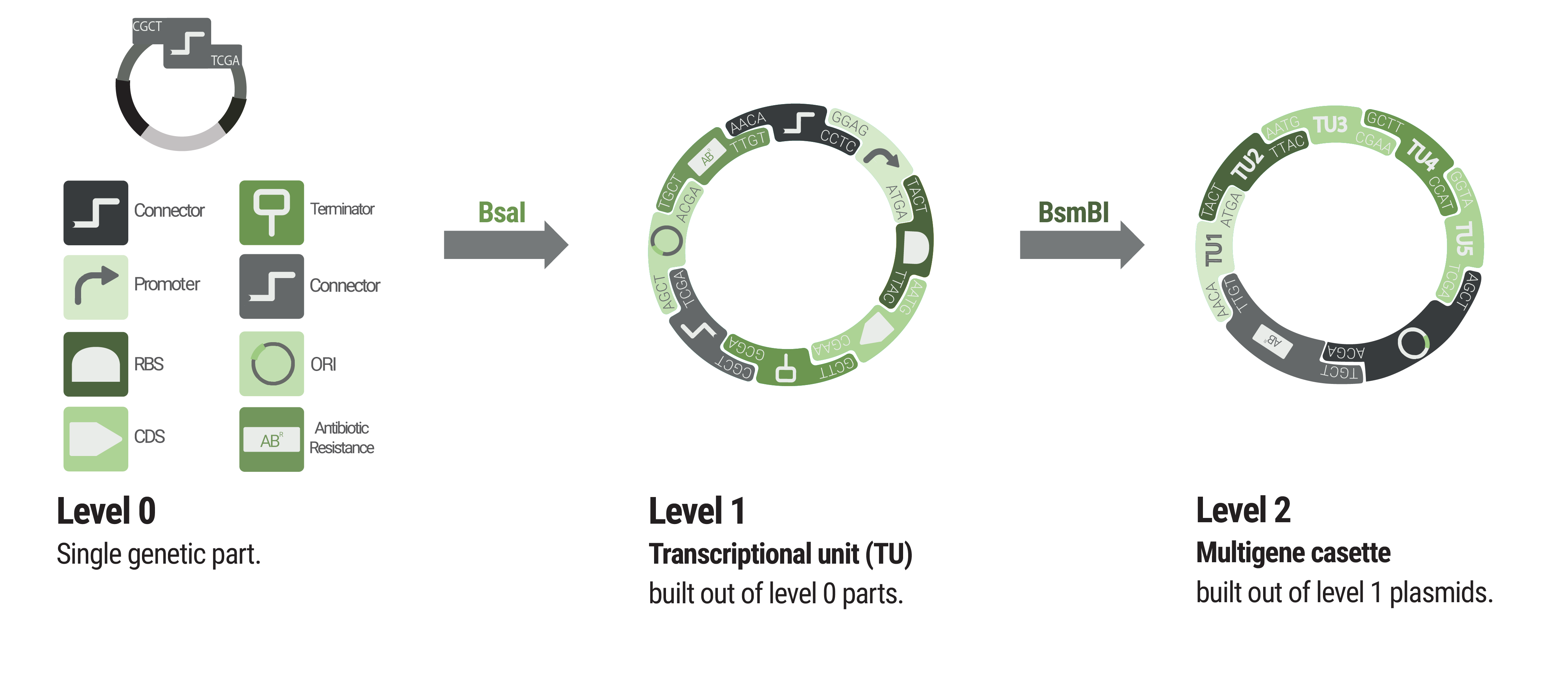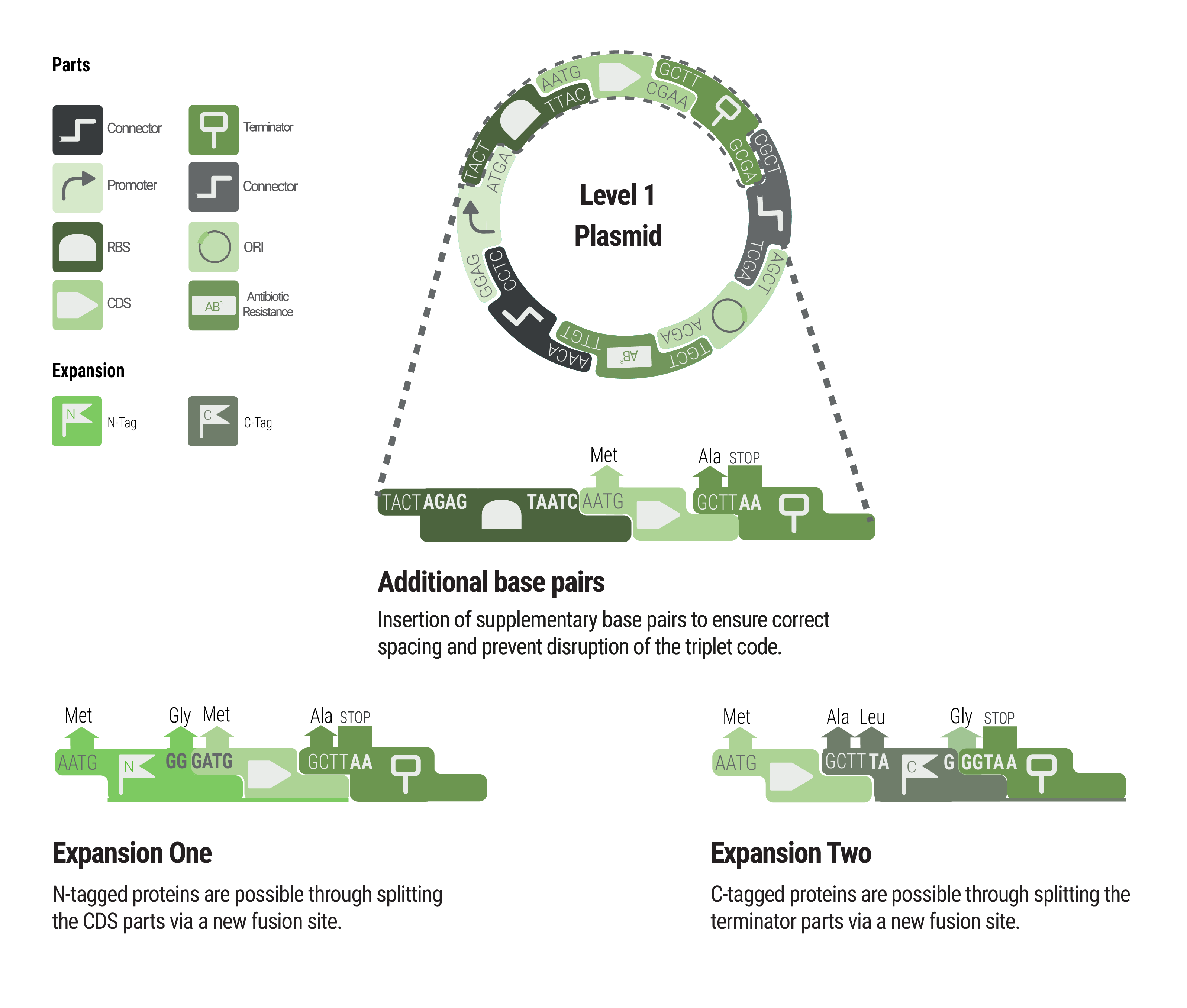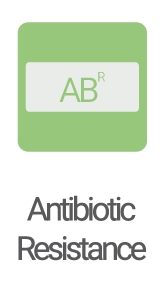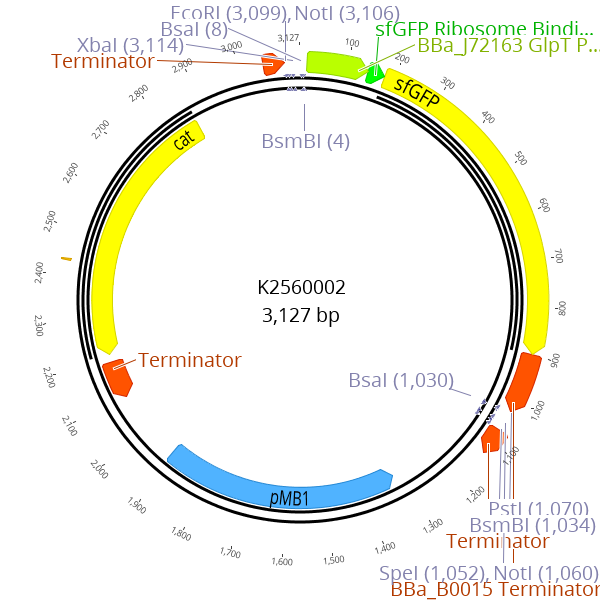|
|
| (13 intermediate revisions by 3 users not shown) |
| Line 5: |
Line 5: |
| | This plasmid can be used to create Phytobricks using a Golden Gate Reaction. A sfGFP dropout helps to distinguish between wrong colonies (green) and correct colonies (white) | | This plasmid can be used to create Phytobricks using a Golden Gate Reaction. A sfGFP dropout helps to distinguish between wrong colonies (green) and correct colonies (white) |
| | | | |
| − | <!-- Add more about the biology of this part here
| |
| − | ===Usage and Biology===
| |
| | | | |
| − | <!-- --> | + | ===Overview=== |
| − | <span class='h3bb'>Sequence and Features</span> | + | |
| | + | <html> |
| | + | <p align="justify"> |
| | + | |
| | + | All LVL0 parts have to be stored in plasmids to allow for amplification and long term storage. To create new LVL0 parts, a PCR product or annealed oligos are cloned into a part entry vector. This vector harbours the resistance and ori that are required for selection and propagation. Furthermore, part entry vectors can be designed in a way that they contain a dropout. This dropout can be a transcription unit for a marker that generates a visible output. The first golden-gate-based toolbox MoClo <a href="https://journals.plos.org/plosone/article?id=10.1371/journal.pone.0016765"><abbr title="A Modular Cloning System for Standardized Assembly of Multigene Constructs">(Weber <i>et al.</i> 2011.)</abbr> </a> used a LacZ alpha transcription unit which can be used for blue white screening in many E. coli cloning strains. This concept was also adapted by iGEMs PhytoBrick system. During the cloning of LVL0 parts, this dropout is replaced by the desired part. When the cloning reaction is transformed into a suitable E. coli strain and the cells are plated on agar plates with supplemented IPTG and X-Gal. Colonies transformed with the religated entry plasmid appear blue while white colonies most probably contain the correctly assembled plasmid. The LVL0 part entry vector in iGEMs PhytoBrick system (BBa_P10500) has been designed as described and can be used for blue white screening.<br> |
| | + | We appreciate the approach of using part entry plasmids with dropouts but, for two reasons, we think that LacZ is not an optimal reporter. First, blue white screening requires the two expensive chemicals IPTG and X-Gal which have to be added to the agar plates. Second, blue white screening is restricted to <i>E.coli </i>strains with an incomplete lac operon that is complemented by the LacZ alpha fragment that is expressed from the plasmid <a href="https://www.ncbi.nlm.nih.gov/pubmed/1093175?dopt=Abstract"><abbr title="Molecular basis of beta-galactosidase alpha-complementation.">(Langley <i>et al.</i> 1975.)</abbr> </a>. Consequently blue white screening is not compatible with a <i>V. natriegens </i>wild type strain (Link zu Improvement Page).<br><br> |
| | + | |
| | + | </p> |
| | + | </html> |
| | + | <html> |
| | + | <ARTICLE align="justify"> |
| | + | |
| | + | <p></html> |
| | + | ===Improvement of BBa_P10500=== |
| | + | <html> |
| | + | <ARTICLE align="justify"> |
| | + | iGEM provides the universal acceptor plasmid <a href=" https://parts.igem.org/Part:BBa_P10500 "> |
| | + | <abbr title=" Link to the iGEM part registry "> |
| | + | BBa_P10500</abbr> |
| | + | </a> for creating new PhytoBricks. This plasmid contained the <i>lacZ-α</i> part in the cloning sites for blue-white screening. As we wanted to establish <i>Vibrio natriegens</i> as a chassis for cloning, we investigated if the wild type strain is compatible with blue-white screening. Unfortunately, cloning using <a href=" https://parts.igem.org/Part:BBa_P10500 "> |
| | + | <abbr title=" Link to the iGEM part registry "> |
| | + | BBa_P10500</abbr> |
| | + | </a> in <i>V. natriegens</i> shows no difference between colonies containing the <i>lacZ-α</i> dropout and those without. |
| | + | To overcome this limitation and to enable fast and reliable cloning with <i>V. natriegens</i>, we decided to establish a new visualization method. Our improved part is a derivative of the iGEM <a href=" https://parts.igem.org/Part:BBa_P10500 "> |
| | + | <abbr title=" Link to the iGEM part registry "> |
| | + | BBa_P10500</abbr> |
| | + | </a> containing a sfGFP dropout as fluorescent selection marker. <p></p> |
| | + | |
| | + | </html> |
| | + | <div style="width:100%;display:flex;flex-direction:row;flex-wrap: wrap; justify-content:space-evenly; align-items:center;"> |
| | + | |
| | + | [[File:T--Marburg--K2560002.png|400px|thumb|left|'''Figure 1''': <b> Plasmidmap of BBa_K2560002 </b> <br> Our improved part BBa_K2560002 is a derivate of the BBa_P10500 containing sfGFP drop out.]] |
| | + | |
| | + | </div> |
| | + | <html> |
| | + | <p> |
| | + | In the pictures 2, you can see the wild type <i>V. natriegens</i> in comparison with the iGEM <a href=" https://parts.igem.org/Part:BBa_P10500 "> |
| | + | <abbr title=" Link to the iGEM part registry "> |
| | + | BBa_P10500</abbr> |
| | + | </a> forming white colonies as well as bright green colonies containing the improved part BBa_K2560002. No differences between the wild type and the <a href=" https://parts.igem.org/Part:BBa_P10500 "> |
| | + | <abbr title=" Link to the iGEM part registry "> |
| | + | BBa_P10500</abbr> |
| | + | </a> containing colonies are noticable. On the contrary, our new BBa_K2560002 part leads to a strong visual distinction to colonies which do not possess the sfGFP. In this way, we created a part for universal LVL0 cloning with a improved selection without the need of additional supplements like Xgal or IPTG. |
| | + | </p><p> |
| | + | Our part not only suits for <i>V. natriegens</i> but is convenient for the frequently used cloning host <i>E. coli</i>. As it can be seen in the picture 3, <i>E. coli</i> containing the sfGFP possess a considerable strong green colour even without the use of UV light and is just or even more distinguishable from the wild type as the <i>lacZ</i> containing blue colonies. By using our improved part BBa_K2560002 instead of the iGEM part <a href=" https://parts.igem.org/Part:BBa_P10500 "> |
| | + | <abbr title=" Link to the iGEM part registry "> |
| | + | BBa_P10500</abbr> |
| | + | </a> work and money for the addition of the required supplements can be saved and the risk of not functional plates for selection is decreased. In our experiments, we were using 40 μg per Liter Xgal and 0,5 mM IPTG. Calculating with current prices, 100 plates supplemented with <a href=" https://www.applichem.com/shop/produktdetail/as/x-gal-ibiochemicai/ "> |
| | + | <abbr title=" link to shop "> |
| | + | Xgal</abbr></a> and |
| | + | <a href=" https://www.carlroth.com/de/de/Chemikalien/A-Z-Chemikalien/I/IPTG/IPTG/p/000000010000911300020023_de "> |
| | + | <abbr title=" link to shop "> |
| | + | IPTG</abbr></a> costs about 80 dollar. </p><p> |
| | + | |
| | + | </html> |
| | + | |
| | + | <div style="width:100%;display:flex;flex-direction:row;flex-wrap: wrap; justify-content:space-evenly; align-items:center;"> |
| | + | |
| | + | [[File:T--Marburg--E.coli+V.natriegens.png|800px|thumb|left]] |
| | + | |
| | + | </div> |
| | + | |
| | + | <br>By using our improved part for cloning, the detection of successfully ligated clones from non is feasible for strains which are not compatible with blue-white screening and therefor becomes more universal, faster and cheaper than before. |
| | + | <br> <br> |
| | + | <span class='h3bb'>Sequence and Features |
| | <partinfo>BBa_K2560002 SequenceAndFeatures</partinfo> | | <partinfo>BBa_K2560002 SequenceAndFeatures</partinfo> |
| | | | |
| Line 17: |
Line 79: |
| | <partinfo>BBa_K2560002 parameters</partinfo> | | <partinfo>BBa_K2560002 parameters</partinfo> |
| | <!-- --> | | <!-- --> |
| | + | |
| | + | ===Marburg Toolbox=== |
| | + | <html> |
| | + | <p align="justify">We proudly present the Marburg Collection, a novel golden-gate-based toolbox containing various parts that are compatible with the PhytoBrick system and MoClo. Compared to other bacterial toolboxes, the Marburg Collection shines with superior flexibility. We overcame the rigid paradigm of plasmid construction - thinking in fixed backbone and insert categories - by achieving complete <i> de novo </i> assembly of plasmids. |
| | + | <br> |
| | + | <br> |
| | + | 36 connectors facilitate flexible cloning of multigene constructs and even allow for the inversion of individual transcription units. Additionally, our connectors function as insulators to avoid undesired crosstalk. |
| | + | <br> |
| | + | <br> |
| | + | The Marburg Collection contains 123 parts in total, including: |
| | + | <br> |
| | + | inducible promoters, reporters, fluorescence and epitope tags, oris, resistance cassettes and genome engineering tools. To increase the value of the Marburg Collection, we additionally provide detailed experimental characterization for <i> V. natriegens </i> and a supportive software. We aspire availability of our toolbox for future iGEM teams to empower accelerated progression in their ambitious projects.</p> |
| | + | |
| | + | </html> |
| | + | |
| | + | |
| | + | <div style="width:100%;display:flex;flex-direction:row;flex-wrap: wrap; justify-content:space-evenly; align-items:center;"> |
| | + | |
| | + | [[File:T--Marburg--Cloning_Overview.png|800px|thumb|left|'''Figure 2''': <b> Hierarchical cloning is facilitated by subsequent Golden Gate reactions. </b> <br> Basic building blocks like promoters or terminators are stored in level 0 plasmids. Parts from each category of our collection can be chosen to built level 1 plasmids harboring a single transcription unit. Up to five transcription units can be assembled into a level 2 plasmid.]] |
| | + | |
| | + | [[File:T--Marburg--Overview_Marburg_Toolbox.png|750px|thumb|middle|'''Figure 3''': <b> Additional bases and fusion sites ensure correct spacing and allow tags. </b> <br> Between some parts, additional base pairs were integrated to ensure correct spacing and to maintain the triplet code. We expanded our toolbox by providing N- and C- terminal tags by creating novel fusions and splitting the CDS and terminator part, respectively.]] |
| | + | |
| | + | |
| | + | </div> |
| | + | |
| | + | ===Parts of the Marburg Toolbox=== |
| | + | |
| | + | <div class="PCListIcon" style="display:flex;flex-direction:row; flex-wrap: nowrap; justify-content:space-evenly; align-items:flex-start;font-size:82%;"> |
| | + | |
| | + | [[File:T--Marburg--5'Con.png|90px|thumb|none| |
| | + | |
| | + | <html> |
| | + | <ul> |
| | + | <b> |
| | + | |
| | + | <li> <a href="https://parts.igem.org/Part:BBa_K2560011">K2560011 </a> (5'Connector Dummy) </li> |
| | + | <li> <a href="https://parts.igem.org/Part:BBa_K2560055">K2560055 </a> <br>(1-6 <br> Connector) </li> |
| | + | <li> <a href="https://parts.igem.org/Part:BBa_K2560065">K2560065 </a> (5'Con1) </li> |
| | + | <li> <a href="https://parts.igem.org/Part:BBa_K2560066">K2560066 </a> (5'Con2) </li> |
| | + | <li> <a href="https://parts.igem.org/Part:BBa_K2560067">K2560067 </a> (5'Con3) </li> |
| | + | <li> <a href="https://parts.igem.org/Part:BBa_K2560068">K2560068 </a> (5'Con4) </li> |
| | + | <li> <a href="https://parts.igem.org/Part:BBa_K2560069">K2560069 </a> (5'Con5) </li> |
| | + | <li> <a href="https://parts.igem.org/Part:BBa_K2560075">K2560075 </a> (5'Con1 <br> Short Res) </li> |
| | + | <li> <a href="https://parts.igem.org/Part:BBa_K2560076">K2560076 </a> (5'Con2 <br> Short) </li> |
| | + | <li> <a href="https://parts.igem.org/Part:BBa_K2560077">K2560077 </a> (5'Con3 <br> Short) </li> |
| | + | <li> <a href="https://parts.igem.org/Part:BBa_K2560078">K2560078 </a> (5'Con4 <br> Short) </li> |
| | + | <li> <a href="https://parts.igem.org/Part:BBa_K2560079">K2560079 </a> (5'Con5 <br> Short) </li> |
| | + | <li> <a href="https://parts.igem.org/Part:BBa_K2560095">K2560095 </a> (5'Con1 inv) </li> |
| | + | <li> <a href="https://parts.igem.org/Part:BBa_K2560096">K2560096 </a> (5'Con2 inv) </li> |
| | + | <li> <a href="https://parts.igem.org/Part:BBa_K2560097">K2560097 </a> (5'Con3 inv) </li> |
| | + | <li> <a href="https://parts.igem.org/Part:BBa_K2560098">K2560098 </a> (5'Con4 inv) </li> |
| | + | <li> <a href="https://parts.igem.org/Part:BBa_K2560099">K2560099 </a> (5'Con5 inv) </li> |
| | + | <li> <a href="https://parts.igem.org/Part:BBa_K2560105">K2560105 </a> (5'Con5 inv <br> Ori) </li> |
| | + | <li> <a href="https://parts.igem.org/Part:BBa_K2560107">K2560107 </a> (5'Con1 <br> Res) </li> |
| | + | |
| | + | </b> |
| | + | </ul> |
| | + | </html>]] |
| | + | |
| | + | [[File:T--Marburg--Promotor.png|90px|thumb|none| |
| | + | |
| | + | <html> |
| | + | <ul> |
| | + | <b> |
| | + | |
| | + | <li> <a href="https://parts.igem.org/Part:BBa_K2560007">K2560007 </a> (J23100) </li> |
| | + | <li> <a href="https://parts.igem.org/Part:BBa_K2560009">K2560009 </a> (J23104) </li> |
| | + | <li> <a href="https://parts.igem.org/Part:BBa_K2560014">K2560014 </a> (J23106) </li> |
| | + | <li> <a href="https://parts.igem.org/Part:BBa_K2560015">K2560015 </a> (J23115) </li> |
| | + | <li> <a href="https://parts.igem.org/Part:BBa_K2560017">K2560017 </a> (J23101) </li> |
| | + | <li> <a href="https://parts.igem.org/Part:BBa_K2560018">K2560018 </a> (J23102) </li> |
| | + | <li> <a href="https://parts.igem.org/Part:BBa_K2560019">K2560019 </a> (J23103) </li> |
| | + | <li> <a href="https://parts.igem.org/Part:BBa_K2560020">K2560020 </a> (J23105) </li> |
| | + | <li> <a href="https://parts.igem.org/Part:BBa_K2560021">K2560021 </a> (J23107) </li> |
| | + | <li> <a href="https://parts.igem.org/Part:BBa_K2560022">K2560022 </a> (J23108) </li> |
| | + | <li> <a href="https://parts.igem.org/Part:BBa_K2560023">K2560023 </a> (J23109) </li> |
| | + | <li> <a href="https://parts.igem.org/Part:BBa_K2560024">K2560024 </a> (J23110) </li> |
| | + | <li> <a href="https://parts.igem.org/Part:BBa_K2560025">K2560025 </a> (J23111) </li> |
| | + | <li> <a href="https://parts.igem.org/Part:BBa_K2560026">K2560026 </a> (J23113) </li> |
| | + | <li> <a href="https://parts.igem.org/Part:BBa_K2560027">K2560027 </a> (J23114) </li> |
| | + | <li> <a href="https://parts.igem.org/Part:BBa_K2560028">K2560028 </a> (J23116) </li> |
| | + | <li> <a href="https://parts.igem.org/Part:BBa_K2560029">K2560029 </a> (J23117) </li> |
| | + | <li> <a href="https://parts.igem.org/Part:BBa_K2560030">K2560030 </a> (J23118) </li> |
| | + | <li> <a href="https://parts.igem.org/Part:BBa_K2560031">K2560031 </a> (J23119) </li> |
| | + | <li> <a href="https://parts.igem.org/Part:BBa_K2560123">K2560123 </a> <br>(pTet) </li> |
| | + | <li> <a href="https://parts.igem.org/Part:BBa_K2560124">K2560124 </a> (pTrc) </li> |
| | + | <li> <a href="https://parts.igem.org/Part:BBa_K2560131">K2560131 </a> (Promoter Dummy) </li> |
| | + | <li> <a href="https://parts.igem.org/Part:BBa_K4237048">K4237048 </a> (plac+TE2) </li> |
| | + | |
| | + | |
| | + | </ul> |
| | + | </b> |
| | + | </html>]] |
| | + | |
| | + | [[File:T--Marburg--RBS.png|90px|thumb|none| |
| | + | |
| | + | <html> |
| | + | <ul> |
| | + | <b> |
| | + | <li> <a href="https://parts.igem.org/Part:BBa_K2560008">K2560008 </a> (B0034) </li> |
| | + | <li> <a href="https://parts.igem.org/Part:BBa_K2560010">K2560010 </a> (B0032) </li> |
| | + | <li> <a href="https://parts.igem.org/Part:BBa_K2560013">K2560013 </a> (B0031) </li> |
| | + | <li> <a href="https://parts.igem.org/Part:BBa_K2560016">K2560016 </a> (B0030) </li> |
| | + | <li> <a href="https://parts.igem.org/Part:BBa_K2560084">K2560084 </a> <br>(RBS Dummy) </li> |
| | + | |
| | + | |
| | + | </b> |
| | + | </ul> |
| | + | </html>]] |
| | + | |
| | + | [[File:T--Marburg--CDS.png|90px|thumb|none| |
| | + | |
| | + | <html> |
| | + | <ul> |
| | + | <b> |
| | + | |
| | + | <li> <a href="https://parts.igem.org/Part:BBa_K2560033">K2560033 </a> (E1010) </li> |
| | + | <li> <a href="https://parts.igem.org/Part:BBa_K2560041">K2560041 </a> (E0030) </li> |
| | + | <li> <a href="https://parts.igem.org/Part:BBa_K2560042">K2560042 </a> (sfGFP) </li> |
| | + | <li> <a href="https://parts.igem.org/Part:BBa_K2560043">K2560043 </a> (sfGFP Vn) </li> |
| | + | <li> <a href="https://parts.igem.org/Part:BBa_K2560047">K2560047 </a> (Cas9) </li> |
| | + | <li> <a href="https://parts.igem.org/Part:BBa_K2560051">K2560051 </a> <br>(Lux Operon) </li> |
| | + | <li> <a href="https://parts.igem.org/Part:BBa_K2560054">K2560054 </a> (dCas9) </li> |
| | + | <li> <a href="https://parts.igem.org/Part:BBa_K2560082">K2560082 </a> <br>(CDS Dummy) </li> |
| | + | <li> <a href="https://parts.igem.org/Part:BBa_K2560114">K2560114 </a> (LacZ Alpha) </li> |
| | + | <li> <a href="https://parts.igem.org/Part:BBa_K2560128">K2560128 </a> (K660004) </li> |
| | + | <li> <a href="https://parts.igem.org/Part:BBa_K2560135">K2560135 </a> <br>(SXT Beta) </li> |
| | + | <li> <a href="https://parts.igem.org/Part:BBa_K2560268">K2560268 </a> <br>(tfox Vc) </li> |
| | + | <li> <a href="https://parts.igem.org/Part:BBa_K2560269">K2560269 </a> <br>(tfox Vn) </li> |
| | + | <li> <a href="https://parts.igem.org/Part:BBa_K2560270">K2560270 </a> <br>(SXT) </li> |
| | + | <li> <a href="https://parts.igem.org/Part:BBa_K2560271">K2560272 </a> <br>(flp recombinase) </li> |
| | + | |
| | + | |
| | + | </ul> |
| | + | </b> |
| | + | </html>]] |
| | + | |
| | + | |
| | + | [[File:T--Marburg--Terminator.png|90px|thumb|none| |
| | + | |
| | + | <html> |
| | + | <ul> |
| | + | <b> |
| | + | <li> <a href="https://parts.igem.org/Part:BBa_K2560034">K2560034 </a> (B0010) </li> |
| | + | <li> <a href="https://parts.igem.org/Part:BBa_K2560035">K2560035 </a> (B0015) </li> |
| | + | <li> <a href="https://parts.igem.org/Part:BBa_K2560081">K2560081 </a> (Terminator Dummy) </li> |
| | + | <li> <a href="https://parts.igem.org/Part:BBa_K2560089">K2560089 </a> (B1002) </li> |
| | + | <li> <a href="https://parts.igem.org/Part:BBa_K2560091">K2560091 </a> (B1003) </li> |
| | + | <li> <a href="https://parts.igem.org/Part:BBa_K2560093">K2560093 </a> (B1006) </li> |
| | + | |
| | + | |
| | + | </b> |
| | + | </ul> |
| | + | </html>]] |
| | + | |
| | + | |
| | + | [[File:T--Marburg--3'Con.png|90px|thumb|none|<html> |
| | + | <ul> <b> |
| | + | <li> <a href="https://parts.igem.org/Part:BBa_K2560012">K2560012 </a> (3'Connector Dummy) </li> |
| | + | <li> <a href="https://parts.igem.org/Part:BBa_K2560070">K2560070 </a> (3'Con1) </li> |
| | + | <li> <a href="https://parts.igem.org/Part:BBa_K2560071">K2560071 </a> (3'Con2) </li> |
| | + | <li> <a href="https://parts.igem.org/Part:BBa_K2560072">K2560072 </a> (3'Con3) </li> |
| | + | <li> <a href="https://parts.igem.org/Part:BBa_K2560073">K2560073 </a> (3'Con4) </li> |
| | + | <li> <a href="https://parts.igem.org/Part:BBa_K2560080">K2560080 </a> (3'Con5 Ori) </li> |
| | + | <li> <a href="https://parts.igem.org/Part:BBa_K2560100">K2560100 </a> (3'Con1 inv <br>Short) </li> |
| | + | <li> <a href="https://parts.igem.org/Part:BBa_K2560101">K2560101 </a> (3'Con2 inv <br>Short) </li> |
| | + | <li> <a href="https://parts.igem.org/Part:BBa_K2560102">K2560102 </a> (3'Con3 inv <br>Short) </li> |
| | + | <li> <a href="https://parts.igem.org/Part:BBa_K2560103">K2560103 </a> (3'Con4 inv <br>Short) </li> |
| | + | <li> <a href="https://parts.igem.org/Part:BBa_K2560104">K2560104 </a> (3'Con5 inv <br>Short) </li> |
| | + | <li> <a href="https://parts.igem.org/Part:BBa_K2560106">K2560106 </a> (3'Con1 inv <br>Short Res) </li> |
| | + | <li> <a href="https://parts.igem.org/Part:BBa_K2560108">K2560108 </a> (3'Con1 inv) </li> |
| | + | <li> <a href="https://parts.igem.org/Part:BBa_K2560109">K2560109 </a> (3'Con1 inv <br>Res) </li> |
| | + | <li> <a href="https://parts.igem.org/Part:BBa_K2560110">K2560110 </a> (3'Con2 inv) </li> |
| | + | <li> <a href="https://parts.igem.org/Part:BBa_K2560111">K2560111 </a> (3'Con3 inv) </li> |
| | + | <li> <a href="https://parts.igem.org/Part:BBa_K2560112">K2560112 </a> (3'Con4 inv) </li> |
| | + | <li> <a href="https://parts.igem.org/Part:BBa_K2560113">K2560113 </a> (3'Con5 inv) </li> |
| | + | |
| | + | </ul> |
| | + | </b> |
| | + | </html>]] |
| | + | |
| | + | |
| | + | [[File:T--Marburg--ORI.png|90px|thumb|none|<html> |
| | + | <ul> <b> |
| | + | |
| | + | <li> <a href="https://parts.igem.org/Part:BBa_K2560036">K2560036 </a> (ColE1) </li> |
| | + | <li> <a href="https://parts.igem.org/Part:BBa_K2560037">K2560037 </a> (pMB1) </li> |
| | + | <li> <a href="https://parts.igem.org/Part:BBa_K2560046">K2560046 </a> (p15A) </li> |
| | + | |
| | + | </ul> |
| | + | </b> |
| | + | </html>]] |
| | + | |
| | + | [[File:T--Marburg--Antibiotic_Resistance.png|90px|thumb|none| |
| | + | <html> |
| | + | <ul> |
| | + | <b> |
| | + | |
| | + | |
| | + | <li><a href="https://parts.igem.org/Part:BBa_K2560048">K2560048 </a> (Cam. Res. RFP) </li> |
| | + | <li><a href="https://parts.igem.org/Part:BBa_K2560056">K2560056 </a> <br> (Kan. Res. (pSB3K3) RFP) </li> |
| | + | <li><a href="https://parts.igem.org/Part:BBa_K2560057">K2560057 </a> <br> (Kan. Res. (pSB3K3) GFP) </li> |
| | + | <li><a href="https://parts.igem.org/Part:BBa_K2560058">K2560058 </a> <br> (Tet. Res. (pSB3T5) RFP) </li> |
| | + | <li><a href="https://parts.igem.org/Part:BBa_K2560059">K2560059 </a> <br> (Tet. Res. (pSB3T5) GFP) </li> |
| | + | <li><a href="https://parts.igem.org/Part:BBa_K2560125">K2560125 </a> (Carb. Res. RFP) </li> |
| | + | <li><a href="https://parts.igem.org/Part:BBa_K2560126">K2560126 </a> (Carb. Res. GFP) </li> |
| | + | <li><a href="https://parts.igem.org/Part:BBa_K2560127">K2560127 </a> (Carb. Res. into BBa_K2560002) </li> |
| | + | <li><a href="https://parts.igem.org/Part:BBa_K2560132">K2560132 </a> (Cam. Res. into BBa_K2560002) </li> |
| | + | <li><a href="https://parts.igem.org/Part:BBa_K2560133">K2560133 </a> <br> (Kan. Res. into BBa_K2560002) </li> |
| | + | <li><a href="https://parts.igem.org/Part:BBa_K2560134">K2560134 </a> <br> (Tet. Res. into BBa_K2560002) </li> |
| | + | |
| | + | </ul> |
| | + | </b> |
| | + | </html>]] |
| | + | </div> |
| | + | |
| | + | ===Tags and Entry Vectors=== |
| | + | <div class="PCListIcon" style="display:flex;flex-direction:row; flex-wrap: nowrap; align-items:flex-start; font-size:82%;"> |
| | + | |
| | + | |
| | + | [[File:T--Marburg--N-Tag.png|90px|thumb|middle| |
| | + | <html> |
| | + | <ul> |
| | + | <b> |
| | + | |
| | + | <li><a href="https://parts.igem.org/Part:BBa_K2560060">K2560060 </a> (E1010 4x) </li> |
| | + | <li><a href="https://parts.igem.org/Part:BBa_K2560063">K2560063 </a> (sfGFP 4x) </li> |
| | + | <li><a href="https://parts.igem.org/Part:BBa_K2560085">K2560085 </a> <br> (His-Tag 4x) </li> |
| | + | <li><a href="https://parts.igem.org/Part:BBa_K2560087">K2560087 </a> (FLAG-Tag 4x) </li> |
| | + | <li><a href="https://parts.igem.org/Part:BBa_K2560129">K2560129 </a> (K660004 4x) </li> |
| | + | <li><a href="https://parts.igem.org/Part:BBa_K2560257">K2560257 </a> (Streptag 4x) </li> |
| | + | |
| | + | |
| | + | |
| | + | |
| | + | </ul> |
| | + | </b> |
| | + | </html>]] |
| | + | |
| | + | |
| | + | [[File:T--Marburg--C-Tag.png|90px|thumb|middle| |
| | + | <html> |
| | + | <ul> |
| | + | <b> |
| | + | |
| | + | <li><a href="https://parts.igem.org/Part:BBa_K2560061">K2560061 </a> (E1010 5a) </li> |
| | + | <li><a href="https://parts.igem.org/Part:BBa_K2560062">K2560062 </a> (B0015 5b) </li> |
| | + | <li><a href="https://parts.igem.org/Part:BBa_K2560064">K2560064 </a> (sfGFP 5a) </li> |
| | + | <li><a href="https://parts.igem.org/Part:BBa_K2560086">K2560086 </a> <br> (His-Tag 5a) </li> |
| | + | <li><a href="https://parts.igem.org/Part:BBa_K2560088">K2560088 </a> (FLAG-Tag 5a) </li> |
| | + | <li><a href="https://parts.igem.org/Part:BBa_K2560090">K2560090 </a> (B1002 5b) </li> |
| | + | <li><a href="https://parts.igem.org/Part:BBa_K2560092">K2560092 </a> (B1003 5b) </li> |
| | + | <li><a href="https://parts.igem.org/Part:BBa_K2560094">K2560094 </a> (B1006 5b) </li> |
| | + | <li><a href="https://parts.igem.org/Part:BBa_K2560117">K2560117 </a> (I11012 5a) </li> |
| | + | <li><a href="https://parts.igem.org/Part:BBa_K2560118">K2560118 </a> (M0050 5a) </li> |
| | + | <li><a href="https://parts.igem.org/Part:BBa_K2560119">K2560119 </a> (M0051 5a) </li> |
| | + | <li><a href="https://parts.igem.org/Part:BBa_K2560130">K2560130 </a> (K660004 5a) </li> |
| | + | <li><a href="https://parts.igem.org/Part:BBa_K2560258">K2560258 </a> (Streptag 5a) </li> |
| | + | |
| | + | |
| | + | </ul> |
| | + | </b> |
| | + | </html>]] |
| | + | |
| | + | |
| | + | [[File:T--Marburg--Entry_Vector.png|90px|thumb|middle| |
| | + | <html> |
| | + | <ul> |
| | + | <b> |
| | + | |
| | + | <li><a href="https://parts.igem.org/Part:BBa_K2560001">K2560001 </a> (Entry Vector with RFP dropout) </li> |
| | + | <li><a href="https://parts.igem.org/Part:BBa_K2560002">K2560002 </a> (Entry Vector with GFP dropout) </li> |
| | + | <li><a href="https://parts.igem.org/Part:BBa_K2560005">K2560005 </a> (Resistance Entry Vector with RFP Dropout) </li> |
| | + | <li><a href="https://parts.igem.org/Part:BBa_K2560006">K2560006 </a> (Resistance Entry Vector with GFP Dropout) </li> |
| | + | <li><a href="https://parts.igem.org/Part:BBa_K2560305">K2560305 </a> (gRNA Entry Vector with GFP Dropout) </li> |
| | + | |
| | + | |
| | + | </ul> |
| | + | </b> |
| | + | </html>]] |
This plasmid can be used to create Phytobricks using a Golden Gate Reaction. A sfGFP dropout helps to distinguish between wrong colonies (green) and correct colonies (white)
All LVL0 parts have to be stored in plasmids to allow for amplification and long term storage. To create new LVL0 parts, a PCR product or annealed oligos are cloned into a part entry vector. This vector harbours the resistance and ori that are required for selection and propagation. Furthermore, part entry vectors can be designed in a way that they contain a dropout. This dropout can be a transcription unit for a marker that generates a visible output. The first golden-gate-based toolbox MoClo (Weber et al. 2011.) used a LacZ alpha transcription unit which can be used for blue white screening in many E. coli cloning strains. This concept was also adapted by iGEMs PhytoBrick system. During the cloning of LVL0 parts, this dropout is replaced by the desired part. When the cloning reaction is transformed into a suitable E. coli strain and the cells are plated on agar plates with supplemented IPTG and X-Gal. Colonies transformed with the religated entry plasmid appear blue while white colonies most probably contain the correctly assembled plasmid. The LVL0 part entry vector in iGEMs PhytoBrick system (BBa_P10500) has been designed as described and can be used for blue white screening.
We appreciate the approach of using part entry plasmids with dropouts but, for two reasons, we think that LacZ is not an optimal reporter. First, blue white screening requires the two expensive chemicals IPTG and X-Gal which have to be added to the agar plates. Second, blue white screening is restricted to E.coli strains with an incomplete lac operon that is complemented by the LacZ alpha fragment that is expressed from the plasmid (Langley et al. 1975.) . Consequently blue white screening is not compatible with a V. natriegens wild type strain (Link zu Improvement Page).















